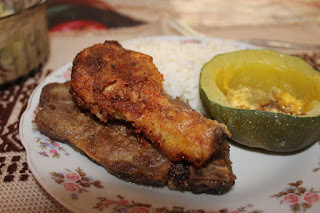On our second Saturday in Namibia, our Namibian trainers took all 31 of us trainees to Windhoek, the national capital city, for a multi-hour tour. We boarded a Sunshine Tours motor coach – very comfortable – and got driven the sixty kilometers to the capital on first-class roads. I stared out the window assiduously, despite the brilliant sunshine drilling directly into my eyeballs (note to self: right hand side of the bus next time), but did not see much in the way of fauna. Cows, of course, and maybe a kudu but maybe a trick of the light and the twisty thorn trees.
Our first stop in the big city was Peace Corps headquarters in the Ausspannplatz neighborhood, where we got MORE SHOTS! from the medical officers. Yay! We all got lots of shots before we left the U.S., including yellow fever and, for me, a measles refresher. My blood work showed I had no measles immunity remaining from my childhood vaccination. Scary, I thought. Once in Namibia, we got rabies shots and, for some (like me), Hepatitis B, both of which required multiple inoculations. Some people had to get flu vaccinations, too. They jabbed us outdoors, on a pleasant garden patio.
 |
| Heroes' Acres plaza |
After that,
we drove about ten kilometers out of town to see the Heroes’ Acres memorial to
the men and women who fought for Namibian independence. This is a beautiful stone plaza surrounded by
hills, containing both actual graves and honorary ones, an obelisk, and a long
uphill climb on a stone staircase to a beautiful belvedere that puts you
more-or-less level with the peaks of three mountain ranges that ring the site. The long climb, our guide told us, was
designed as a reminder of the suffering people endured as they struggled for
freedom. It is an absolutely beautiful
space, and I was deeply moved to visit it.
Our Namibian guide and facilitators were as well – Namibia achieved
independence just 25 years ago, so many of the people with whom we work were
involved in the struggle. One of the
youngest staff members uses an English name with us, but her name at home means
‘End of the World.’ She was born in a
period of terrible fighting in her area, and her parents thought their world
might truly end before their daughter’s life fully began.
 |
| A magnificent place for contemplations |
We also
visited the site of some of the early fighting in the Windhoek area, when in
1959 people protested the apartheid laws that allowed the government to force
them to move from their homes into new neighborhoods to suit the convenience of
others. That area is now a cemetery, and
includes a mass grave containing the bodies of about a dozen Namibians shot by police
during a protest.
 |
| Metaphor |
Then we went
to the mall. We bought bedroom slippers
and index cards to turn into language-practice flash cards and cheeseburgers
and sleeping bags and I found a yoga mat.
Also, I discovered Yaeli’s and their fabulous fresh juices. I got one with mint in it, and I wished I
could move into the glass and just stay there forever.
Next stop was Katutura, the neighborhood to which those protesters were forcibly removed in 1959. It has grown and largely prospered since, and now contains one of the major hospitals, thousands of homes and several markets, including Single Quarters, where you can get mopane worms and many other tasty treats. The dried worms, to my taste, were pretty much flavorless and unpleasantly chewy.
What with parking issues and other slow-downs, we didn’t have time to visit the national museum. I am still saving that for another day. I sat on the left side of the bus headed back to Okahandja, and so had the setting sun to drill itself into my skull. I saw some baboons on a hill.
Next stop was Katutura, the neighborhood to which those protesters were forcibly removed in 1959. It has grown and largely prospered since, and now contains one of the major hospitals, thousands of homes and several markets, including Single Quarters, where you can get mopane worms and many other tasty treats. The dried worms, to my taste, were pretty much flavorless and unpleasantly chewy.
What with parking issues and other slow-downs, we didn’t have time to visit the national museum. I am still saving that for another day. I sat on the left side of the bus headed back to Okahandja, and so had the setting sun to drill itself into my skull. I saw some baboons on a hill.
 |
| I've never seen a better epitaph. |







